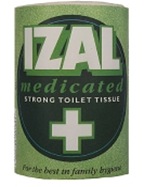Chi ha apprezzato i primi due diari di Adrian Mole potrebbe trovare interessante una conversazione con la loro autrice, Sue Townsend, ascoltabile nel sito di The Guardian
(è piuttosto lunga ma si può scaricare il podcast).
I diari sono ambientati nella prima metà degli anni ‘80 in Inghilterra e il protagonista è un ingenuo adolescente che si crede un intellettuale. Durante l’intervista viene citata un’osservazione fatta da Adrian dopo essere andato per la prima volta da Sainsbury’s, un supermercato considerato esclusivo da chi, come lui, appartiene alla working class:
| But I must say that I take my hat off to Sainsbury’s, they seem to attract a better class of person. I saw a vicar choosing toilet paper; he chose a four-roll pack of purple three-ply. He must have money to burn! He could have bought some shiny white and given the difference to the poor. What a hypocrite! |
Il riferimento a shiny white mi ha fatto tornare in mente uno dei tanti shock culturali del mio primo soggiorno studio in Inghilterra, ai tempi del liceo: la carta igienica dei bagni pubblici (scuole, piscine, treni, pub ecc.), in rotolo o foglietti impilati, usata anche nelle case di alcune famiglie che ospitavano studenti stranieri. Era fatta di un materiale translucido molto simile alla carta oleata, piuttosto rigido e con potere assorbente praticamente nullo (un compagno di corso aveva fatto la prova: inclinando un foglietto, si poteva facilmente fare scorrere delle gocce d’acqua da un’estremità all’altra mantenendole integre).
 Non ero la sola a domandarmi come mai in Gran Bretagna ne facessero così vasto uso, vista l’inadeguatezza allo scopo, ma il mio inglese non all’altezza e il tipo di argomento mi avevano impedito di indagare e di capire che si trattava di un prodotto “medicato”. Negli anni successivi gli incontri ravvicinati erano drasticamente diminuiti perché nel frattempo ne era cessata la produzione e così solo ora scopro che neanche gli inglesi apprezzavano particolarmente l’orrenda carta igienica, come si può leggere in un articolo di The Times:
Non ero la sola a domandarmi come mai in Gran Bretagna ne facessero così vasto uso, vista l’inadeguatezza allo scopo, ma il mio inglese non all’altezza e il tipo di argomento mi avevano impedito di indagare e di capire che si trattava di un prodotto “medicato”. Negli anni successivi gli incontri ravvicinati erano drasticamente diminuiti perché nel frattempo ne era cessata la produzione e così solo ora scopro che neanche gli inglesi apprezzavano particolarmente l’orrenda carta igienica, come si può leggere in un articolo di The Times:
| […] the medicated Izal toilet roll — now sufficiently a part of history for us to get nostalgic about it rather than hating it as much as we did at the time. For those too young and fortunate not to have experienced it, the Izal loo roll was a sort of shiny white thing with the consistency of lino (it was best to scrunch it up before use, make it a bit more malleable) and smelling of coal tar. It didn’t do its job properly, tending to — how to put this delicately — spread the work rather than clean it up. Put another way, it … OK, maybe better not put it another way. Ask an older person if you’re that interested. […] the growth of the inside lavatory meant many more people went for the Izal and its cheaper, non-medicated competing brands than the more traditional forms of tending to your bitt-bott, such as torn up newspapers and string sacks that had formerly contained oranges. A cunning marketing campaign whereby municipal buildings were given free rolls in exchange for placing bulk orders of the disinfectant made going to a public lavatory an ordeal by fire for decades. By the Sixties, though, a more sophisticated clientele demanded a toilet roll that wouldn’t do untold damage to the perineum, and by the late Eighties the Izal roll was no more. The surprising thing was that it took that long to die off. |
Ne parla anche The Guardian in un elenco di 101 cose di cui non si sente la mancanza:
| 61 Izal toilet paper Was it really cheaper, the shiny, scratchy stuff that could actually draw blood if you lost concentration for a moment and became over-vigorous? Or was it some kind of tease campaign, to ready us for Andrex, and teach us to greet it with proper delight? [Andrex = Scottex, stesso tipo di pubblicità con cucciolo di labrador] |
Sembra però che ultimamente questo tipo di carta igienica sia stato reintrodotto sul mercato, come riporta The Independent, con una certa perplessità, in Minor British Institutions: Izal toilet paper. Mah!
…
Vedi anche: qualche esempio dai primi due diari di Adrian Mole in
| ▄ | Narcisi, cultura inglese e traduzione (riferimenti culturali impliciti: un plagio volutamente penoso di I Wandered Lonely as a Cloud di William Wordsworth) |
| ▄ | Traduzione enogastronomica e La traduzione di nomi di alimenti nei diari di Adrian Mole (riferimenti a piatti e prodotti tipici) |
| ▄ | Traduzione di nomi propri: Maxwell House (adattamento e traduzione di nomi propri di persona) |
…
